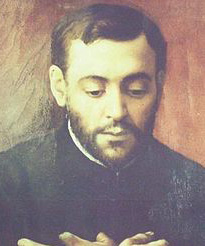Saint of the Day Online - St Isaac Jogues
Saint of the day online, Thursday, October 19, 2017
18-10-2017
Saint Name: St Isaac Jogues
Place: Kingdom of France
Birth: 10 January 1607
Death: 18 October 1646 (aged 39)
Feast: October 19
St Isaac Jogues who was born on 10 January 1607 was a Jesuit priest, missionary and martyr who traveled and worked among the Iroquois, Huron, and other Native populations in North America.
He was the first European to name Lake George, calling it Lac du Saint Sacrement (Lake of the Blessed Sacrament). In 1646, Jogues was martyred by the Mohawk at their village of Ossernenon, south of the Mohawk River.
Jogues was inspired by the missionaries that had returned to France in 1636: Father Brebeuf, Father Charles Lalement and Father Masse to venture to New France.These missionaries told Jogues of their hardships, treacheries and tortures which ordinarily awaited them by the native population, as missionaries in New France. Their accounts however, increased Jogues' desire to “devote himself to labor there for the conversion and welfare of the natives”. Soon after Jogues was ordained a priest in January 1636, he accepted service in the missions and embarked to New France with several other missionaries. Jogues was assigned as a missionary to the Huron and Algonquian peoples; both were allies of the French in Quebec.
Jogues sailed from France on 8 April 1636, and eight weeks later his ship dropped anchor in the Baie des Chaleurs. Jogues arrived in Quebec only several weeks later on 2 July. On arrival, Jogues wrote to his mother: “I do not know it is to enter Heaven, but this I know-- that it would be difficult to experience in this world a joy more excessive and more overflowing than I felt in setting foot in the New World, and celebrating my first Mass on the day of Visitation".
For years, Jogues lived in the village of St. Joseph (Ihonatiria) and learned the ways and language of the Hurons. The missionaries “accommodated themselves to the customs and food of the savages” as much as possible to show the Indians that they intended to share their life. Gradually, the native people began to accept Jogues. This did not last long however, as there were some Indians who had been “among the English and Dutch settlers to the south” who spread reports that the missionaries brought “calamity wherever they went and that they had in consequence been driven out of Europe”.
In 1642 the Huron country was in great distress. Harvests were poor, sickness abounded, and clothing was scarce. Quebec was the only source of supplies, and Isaac Jogues was chosen to lead an expedition. It reached its objective safely and started back well supplied with goods for the mission, but the Iroquois, the bitter enemies of the Hurons, and fiercest of all Indian tribes, were on the war-path and ambushed the returning expedition. The story of the ill-treatment and torture of the captives cannot be told here. Suffice it to say that Jogues and his assistant, Rene Goupil, besides being beaten to the ground and assailed several times with knotted sticks and fists, had their hair, beards and nails torn off and their forefingers bitten through. What grieved them far more, was the cruelty practiced on their Christian converts. The first of all the martyrs to suffer death was Rene Goupil, who was tomahawked on September 29, 1642, for having made the Sign of the Cross on the brow of some children. This Rene Goupil was a remarkable man. He had tried hard to be a Jesuit and had even entered the Novitiate, but his health forced him to give up the attempt. He then studied surgery and found his way to Canada, where he offered his services to the missionaries, whose fortitude he emulated. Rene Goupil is one of the North American martyrs who died at the hands of the Indians between the years 1642-1649.
Their feast day is October 19.